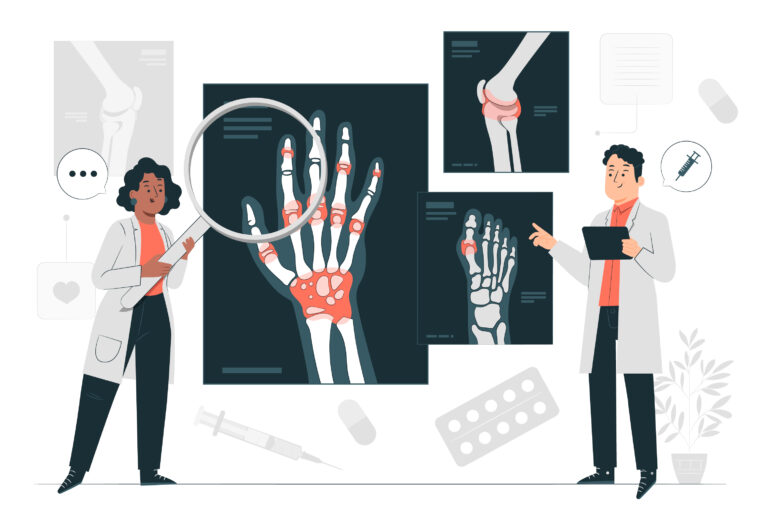Facet joints are vital for the stability and suppleness of our spine, yet when injured or worn down they can be a source of intense discomfort. In this post, we will explore the intricacies of facet joints and how damage or degeneration can cause pain, as well as discuss various diagnostic techniques and treatments for managing it.
We will discuss the diagnostic process for identifying facet joint issues using advanced imaging techniques such as X-rays and MRI scans, as well as diagnostic blockage procedures. You’ll learn about conservative management methods like physical therapy approaches and commonly prescribed medications that can provide relief from facet-mediated pain.
Moving forward, we will explore advanced treatment options including facet joint injections and radiofrequency ablation (RF), which have shown promising results in providing long-term relief for patients suffering from lumbar facet arthropathy. Additionally, you’ll gain insight into structural parameters within these joints such as orientation and tropism – both essential aspects to consider while diagnosing lower back pain related to facets.
Lastly, we’ll take an alternative approach by examining Facet Theory’s application outside biomechanics through multidimensional data visualization. This unique perspective demonstrates the wide range of possibilities offered by understanding facets at a deeper level.
Table of Content
- Facet Joints: The Culprit Behind Your Lower Back Pain
- Anatomy and Function of Facet Joints
- What Causes Facet Joint Degeneration?
- Diagnosing Facet Joint Pain
- Imaging Techniques Used for Diagnosis (X-rays & MRI)
- Diagnostic Blockage Procedure
- Conservative Management Methods for Treating Facet Joint Pain
- Physical Therapy Approaches
- Medications Commonly Prescribed
- Advanced Treatment Options – Facet Injections and Radiofrequency Ablation (RF)
- Facet Injections: Procedure and Benefits
- Radiofrequency Ablation (RF): How It Works and Its Effectiveness
- The Importance of Structural Parameters in Facet Joints
- Facet Theory: A Unique Approach to Multidimensional Data Visualization
- What is Facet Theory?
- Applications of Facet Theory
- FAQs in Relation to Facet
- What are facet joints and their purpose?
- What is the best treatment for facet joint pain?
- What activities aggravate facet joints?
- Why is facet joint pain so bad?
- Conclusion
Facet Joints: The Culprit Behind Your Lower Back Pain
Anatomy and Function of Facet Joints
What Causes Facet Joint Degeneration?
- Osteoarthritis: Normal wear-and-tear processes can lead to osteoarthritis, causing inflammation and stiffness around affected areas.
- Injury: Trauma from accidents or sports injuries can damage facets, causing localized discomfort.
- Poor Posture: Chronic poor posture puts excessive strain on certain parts of your spine, exacerbating existing issues.
Understanding the anatomy and function of facet joints, as well as the causes of degeneration or damage within them, is essential for patients seeking relief from chronic low back pain. Alternative approaches like Facet Theory [1] offer valuable insights into multidimensional data visualization techniques.
Diagnosing Facet Joint Pain
Imaging Techniques Used for Diagnosis (X-rays & MRI)
Medical professionals utilize X-rays and MRI to recognize any anomalies or degenerative alterations in the facet joints. X-rays [2] provide a clear view of your spine’s bony structures, while an MRI scan offers a more detailed look at soft tissues surrounding these joints.
Diagnostic Blockage Procedure
These medications can help alleviate some of your symptoms temporarily while further testing takes place. The information gathered through these diagnostic methods is crucial in determining the most suitable treatment approach for your facet joint pain.
Conservative management options like physical therapy may be sufficient to address your discomfort, but more advanced treatments might be necessary if your pain persists or worsens despite these efforts.
Conservative Management Methods for Treating Facet Joint Pain
Physical Therapy Approaches
Medications Commonly Prescribed
Advanced Treatment Options - Facet Injections and Radiofrequency Ablation (RF)

Facet Injections: Procedure and Benefits
Radiofrequency Ablation (RF): How It Works and Its Effectiveness
RF disrupts nerve pathways responsible for carrying pain signals, providing significant relief for up to two years in some patients.[3]
- Studies show RF reduces the need for pain medications.
- RF may not target the source of discomfort, and in some cases it might need to be performed multiple times.
The Importance of Structural Parameters in Facet Joints
Understanding the orientation and tropism of lumbar facet joints is crucial in identifying their role in causing chronic low back pain. Abnormal facet joint orientations can lead to increased stress on spinal structures, resulting in an increased risk for developing lower back pain and other spine-related disorders. Facet tropism, or asymmetry between left and right facet joint angles, can cause excessive pressure on one side of the intervertebral discs, leading to chronic lower back pain symptoms over time.
Research has shown that individuals with significant facet tropism may experience higher rates of lumbar disc degeneration due to uneven distribution of load across the spinal column. By understanding these structural parameters, healthcare professionals can better diagnose and treat chronic lower back pain caused by facet joint dysfunction.
This knowledge also paves the way for further research into developing more effective therapies targeting specific spinal abnormalities related to facet joints.
FAQs in Relation to Facet
Common treatments for facet joint pain include physical therapy, medications, facet injections, and radiofrequency ablation.
Facet joint pain can be severe due to inflammation and degeneration of cartilage between facets causing nerve irritation and increased friction during movement.
Conclusion
Facet joints are a big deal when it comes to spine pain, so it’s important to know their anatomy and function; degeneration or damage within them can lead to chronic back pain that requires diagnosis using imaging techniques such as X-rays and MRI.
Don’t fret though, treatment options for facet joint pain include physical therapy, medications, injections, and radiofrequency ablation (RF) and structural parameters such as orientation and tropism also impact lower back pain. And if you’re feeling adventurous, alternative approaches like Facet Theory can be used for multidimensional data visualization outside of biomechanics.




